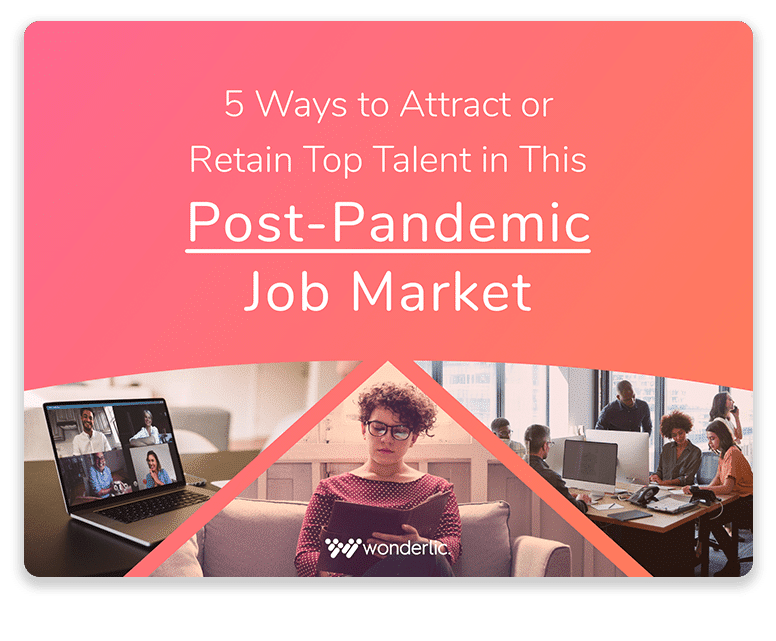In the face of this strange post-pandemic talent market, employers are trying to adapt quickly to remain competitive, deliver a great candidate experience, and hire the best employees to move their organization forward.
The rise of remote work has affected almost every industry, but some are facing unique challenges (and seeing unique opportunities) as the world slowly opens back up.
To get a sense of what’s happening on the ground these days, we talked with two Chicago recruiting experts—Lindsay Brown, a recruiter at Jellyvision, makers of the benefits communication software platform, ALEX, and Maria Selvaggio, VP of People at fintech company M1 Finance.

Right now, there’s a flood of new talent entering the market, but simultaneously, many employers are struggling to find quality talent. Are you dealing with this problem, and if not, what’s proving to be the most challenging part about hiring right now?

Lindsay Brown
Recruiter, Jellyvision
“The hiring right now is just insane. Specifically, at Jellyvision in the past three years, I haven't seen anything quite like this, and we all thought this was going to take a little bit longer to bounce back.
The biggest thing that we're seeing out there with a flood of talent on the market is there are a lot of people who spent time working in jobs they didn't want to work in, but they had to.
During the pandemic, it was about job security and now we see people searching. And what we've seen, which has been so interesting, is that we’ll get folks to an offer phase, make them an offer, and then they’ll go back to their current employer and say, ‘I’m going to go work for this other place.’
Their employers are in the same position we're in— they don't want to lose that talent—so we're seeing loads of counteroffers come through. So while there’s talent out there in the market, I think a lot of recruiters are having trouble getting them in the door, because companies realize it costs less to increase pay and retain an employee than it does to hire their replacement."
"I think a lot of recruiters are having trouble getting [talent] in the door, because companies realize it costs less to increase pay and retain an employee than it does to hire their replacement."
"We hadn't seen this as much in the past. Before, many companies would have countered and said, ‘Maybe it's your time to move on,’ instead of offering more money. That's been really surprising and a little challenging for us as the counteroffers are really sneaking up.”
This candidate’s market also puts the onus on recruiters to help candidates weigh the pros and cons of multiple offers.
“It's a delicate balance because at a certain point, recruiters want to say, ‘If your current employer didn't offer this to you previously, are you sure you want to stay?’ You want to be polite and respectful, but you also want to find out what candidates are looking for in a new position and why they were looking in the first place.
As a recruiter, a lot of the work is becoming a bit of a job therapist. When you get to that offer phase, you’re trying to walk them through the reasons they were looking to begin with, even if they weren’t passive talent. They can be active talent who sought us out and applied, and we’re still talking them through that. And sometimes we'll look at what their counteroffer is really going to come down to in dollars and figure out if we can match that counteroffer.”
"When you get to that offer phase, you’re trying to walk them through the reasons they were looking to begin with, even if they weren’t passive talent."
When push comes to shove, it’s helpful to go beyond talking just about salary.
“Sometimes it’s just reminding them about everything we can offer. This great culture we have, our incredible work life balance, our amazing paid time off policy, and [the appeal of] working on new products. Illustrating the whole package can be pretty persuasive, but it really just boils down to the person. And that's the tricky part. People are tough to figure out and they have different priorities sometimes.”

Maria Selvaggio
VP of People, M1 Finance
“We were very fortunate throughout the pandemic, we never slowed down. We grew pretty substantially where other companies had totally stopped. At the beginning of the pandemic, we were about 50 people, and today we have around 265 employees.
There were still recruiting challenges, but it was a lot easier to hire really great people than I had ever seen before. In the past, especially on the tech side, we had people applying and coming to us.
Now, however, what we’re finding is that more companies are hiring, so we have a little bit more competition than we did before, so it's not quite like shooting fish in a barrel—now we have more work to do on our end.”
In particular, M1 Finance is now dealing with competitive offers from companies beyond Chicago.
“We're not only dealing with a lot of demand from other companies in Chicago, now we're dealing with demand from everywhere. Now that everyone's allowing people to work remotely, companies in San Francisco and New York are poaching talent from Chicago because it doesn't matter where the employees are. Netflix, Facebook and Google have reached out to every single one of our engineers, and what's tough is they're offering San Francisco or New York market compensation.
"Now that everyone's allowing people to work remotely, companies in San Francisco and New York are poaching talent from Chicago because it doesn't matter where the employees are."
It’s not just tech roles, either. We’re dealing with the same competition for marketing and other non-tech positions, too. This means the people who come work with us based out of Chicago have much broader options for potential employers than they did before the pandemic.”
These changes have prompted M1 to find new ways to be competitive.
“As a result of all this, we’ve changed our pay structure: specifically, we’ve increased the cash that we pay out. Before we were pretty equity-heavy, but earlier this year we did a big true-up so that people were making market. They're also earning equity and that's a big, lucrative, part of their total compensation, and we hope they realize the value of coming into a company like ours really early that has all of this great equity built up.
Also, we’ve moved to a review cycle where we're evaluating pay structure every six months instead of every year so that we aren't making people wait a year for an increase. If they're in jeopardy of being poached, we can increase their compensation on a more regular basis.”

How has the pandemic and the shift to remote work changed your company’s overall approach to hiring?

Lindsay Brown
Recruiter, Jellyvision
“It’s been a huge win for us being able to hire folks who can be full-time remote but work in a different state.
We've seen great talent come out of places like Florida, Georgia, North Carolina, Kentucky, and Ohio. It's really been nice to be able to tap other markets. From a candidate perspective, it would be great to work at a tech company out of Chicago but maybe you have to live in Ohio for some reason, so I think it's been helpful for both parties there.”
Beyond adding more flexibility to candidate sourcing, Jellyvision has made a point to create an even more flexible company culture.
“At Jellyvision, we pretty quickly recognized that now we're spending all of our time on Zoom and Zoom fatigue is real. In the winter, on Fridays, we would discourage team members from using Zoom after 1:00pm and try to avoid scheduling internal meetings during that time.
We had such a great response to it that we kept it, so now Fridays are Focus Fridays and we try really hard not to have Zoom meetings on Fridays, and no meetings at all after 1:00pm. That way, you have the afternoon to do a little bit of heads down work.”

Maria Selvaggio
VP of People, M1 Finance
“Before the pandemic, we would have always said every single person has to be in Chicago, no exception. And now we've opened up our talent search where we're looking to most of the United States.
In terms of interviewing and onboarding, we’ve built up this really seamless virtual interview and virtual onboarding process.
Interviewing is pretty similar to the pre-pandemic era. We keep them about the same length but we do allow people to split it up if they need to, which is different than before. Before, when someone would come in, they would need to take a whole day off. But now, we'll do an hour or two of interviews over a couple of days, and it doesn't have a negative impact for us.”
"Before, when someone would come in, they would need to take a whole day off. But now, we'll do an hour or two of interviews over a couple of days, and it doesn't have a negative impact for us."
"Having said that, right now we’re trying to decide whether we are going to change that process. Will we start making candidates come into the office again or are we going to continue to interview virtually? We're moving to a hybrid model with our employees, allowing them to work from home a little bit more than they did in the past.
But if we're doing on-site interviews, the worst thing in the world would be a candidate who's coming in and then meets five people over video. So we're either going to have everybody come in every single time, no exceptions, or we're going to have to continue doing interviews virtually.”

Last question: How do you assess whether candidates are a good fit—and how has the shift to remote work changed your approach, if at all?

Lindsay Brown
Recruiter, Jellyvision
“We have a job-specific exercise as part of the process. The exercise is determined role by role, so some exercises we previously did in person, we've had to really change and make accommodations for remote interviewing and that was super challenging.
We pivoted to virtual overnight and we had to figure out how to do cold call simulations for sales folks on Zoom, for example. Zoom needs to have all these people in a room and we had to learn how to use breakout rooms, and that was a little bit difficult.”
Being strategic about which steps in the vetting process are most valuable is crucial in this competitive market.
“We still really rely on those exercises so right now we try really hard to keep it down to three or four steps at most. There are so many people out there and time is valuable. If an interview process takes a little bit longer, you have a better chance of losing a candidate to another company that has a shorter process.
For a lot of roles, especially for the tech side, we do code reviews. I’ve heard of a lot of companies dropping that because they want to get faster about bringing folks in. I can empathize with that, but those assessments are super-helpful and they help both parties. The hiring team wants to know if a candidate can do what they say they're going to do, especially when roles require a lot of coding skills. And it's helpful for a candidate to understand what they would be doing day in and day out.
Both sides can determine whether it’s a good fit. We're always open to shifting and changing but so far it's worked out pretty well for us with keeping that exercise in the process.”

Maria Selvaggio
VP of People, M1 Finance
“When candidates apply, the first step is going to be a resume review by the recruiter. The recruiter knows what they're looking for, so they screen for the basics. They’re asking, are you, at a very high level, capable of doing the role, interested in the role, and do you fit our compensation? Also, if this is a role that has to be totally in Chicago, are you based in the right location?
The initial screen covers all of those logistics questions. And then we move on to the next step which is a little bit varied. Depending on which role it is, it's either a phone screen with the hiring manager or the recruiting team does a technical screen, which is like a coding interview for all the technical roles. Some roles will do an assessment at that time, which can be anything like a marketing case study or projects to present during their on-site interview.
If they're not doing a phone screen, we have them do some kind of assessment. We always have something in that mid-stage before we do a full interview (virtually, right now). And if you've done something or you've done a project, you'll present it onsite. We try to keep that pretty minimal and get all the information we need up to this point, so we don't have more than one on-site interview.”
"If they're not doing a phone screen, we have them do some kind of assessment. We always have something in that mid-stage before we do a full interview (virtually, right now)."
Limiting the number of on-site interviews is just one way that M1 improves candidate experience.
“As far as assessments go, we’ve had some groups in the past that haven't thought it all the way through and then we'd try to throw an assessment in at the end of that process, like after the on-site interview, and that's a huge turnoff for a candidate.
When a candidate has already spent six hours with you, they’re not going to be excited about doing an assessment or a research project for you. Those things work much better earlier in the recruiting process.”
Want to learn more about landing top talent in this candidate's job market?


